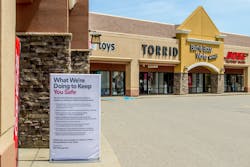Widespread store and restaurant closures, vacant office buildings and manufacturing facilities – no industry has been untouched by COVID-19, and many are scrambling to adjust to new restrictions. As businesses navigate safely reopening during this evolving health crisis, one thing is clear: Businesses must significantly change the way work is conducted by focusing on more sustainable technologies and solutions.
In this area, security integrators should see an opportunity to evaluate a customer’s existing security and educating them on the advantages of making long-term investments in security that can provide both immediate benefits for those struggling to get back to work, as well as provide long-term benefits when the crisis has passed.
One rapidly emerging area is the combination of IoT and security cameras, which couples a camera’s extensive capabilities in processing visual data with the flexibility and connectivity of IoT.
IoT is revolutionizing the way we use surveillance cameras, much the same way Android revolutionized smartphones. By effectively turning surveillance cameras into multi-purpose sensors, integrators can offer customers the ability to pick and choose appropriate camera applications that produce actionable intelligence far beyond what traditional surveillance footage can provide.
This enables systems integrators to work alongside their customers to build tailor-made solutions for nearly any requirement; or alternatively, enables integrators to customize their own offerings by bundling camera apps by vertical market or application. This ability to flexibly convert cameras for other application areas throughout their lifecycle enables customers to get the most out of their hardware investment.
Health and Safety Guideline Adherence
As businesses adjust to evolving pandemic guidelines, integrators should offer solutions that address key reopening goals, including occupancy restrictions, social distancing requirements and other measures meant to limit the risk of infection. Smart security cameras can assist, as they are connected to the IoT and equipped with video analytic applications that can partially, or fully, automate building occupancy management by monitoring multiple entrances and exits to track occupancy levels – a crucial step to maintaining a safe environment.
Taking it a step further, crowd detection applications can detect people and the distances between them, providing a comprehensive occupancy report. Data from these applications offer a picture of crowd density across an entire facility, which is particularly ideal for large locations, such as a retail plaza or public park.
Such a “big picture” can be used to adjust layout where individuals get too close to one another. By placing smart cameras near chokepoints, building managers and owners can determine if increased signage to encourage social distancing is needed, if floor markers are necessary to maintain proper spacing, or whether other measures should be implemented to ensure a safer experience.
Using smart cameras equipped with object detection analytics, the enforcement process of health and safety policies can be automated. For example, security personnel can be alerted to an individual entering a facility without a face covering, enabling the identification of problem areas and increased safety notifications where needed. Analytics can also track and determine the average number of people who violate the policy.
Helping with Overall Facility Design
Data provided by smart surveillance devices can assist security managers in effectively organizing foot traffic, while adhering to social distancing and occupancy limitations.
For building managers, people-counting or flow detection applications can improve future building or lobby design in terms of furniture placement or removal of obstructions that cause bottlenecking at the base of escalators, in stairwells or chokepoints at access points.
Conversely, as many businesses are considering adopting a longer-term virtual workforce model, smart security camera applications can help facility managers evaluate building usage for space utilization or real estate decisions.
Beyond COVID-19
While smart cameras and IoT sensors can serve as valuable reopening tools, their value extends far beyond COVID-19 uses, and they should be repurposed tomorrow to improve retail, manufacturing and office building safety, as well as the visitor experience. Integrators must be willing to educate end-users on the benefits of sustainable, long-term technology solutions that will solve today’s pain points, while planning for tomorrow. Here are some examples:
In retail: Analytics have long been a business tool for retail customers. For example, retailers can use analytics for loss prevention and health safety efforts, as well streamlining operations through analyzing customer behavior. By assessing customer traffic over time, managers can plan for peak periods and zones and take advantage of upselling opportunities in highly trafficked areas. Object detection applications can monitor stock volume in shelves and notify staff to refill before items are sold out. Zone counter applications – used for occupancy management during COVID reopening – can be used for analyzing interactions with a particular shelf or area of a store once things are back to normal. This enables managers to better manage inventory to meet customer demand.
In offices and other commercial spaces: Smart cameras and their applications can improve user experience by adapting air conditioning levels to room occupancy. By detecting how many people are in one location over a certain period of time, analytics can provide data to help control ventilation or heating according to demand. Where basic facility maintenance and administrative help is required, cameras can identify open work and meeting spaces, assess the cleanliness of each area, and make a record of the last time an area had been sanitized.
Additionally, they are able to identify if conference room lights or devices have been left on, notify personnel of stock items needed in office break rooms, and can even provide early fire detection.
Fabio Marti is Head of Marketing for Security & Safety Things. Request more info on the company at www.securityinfowatch.com/21040488.
About the Author
Fabio Marti
Fabio Marti is Head of Marketing for Security & Safety Things. Request more info on the company at www.securityinfowatch.com/21040488.
